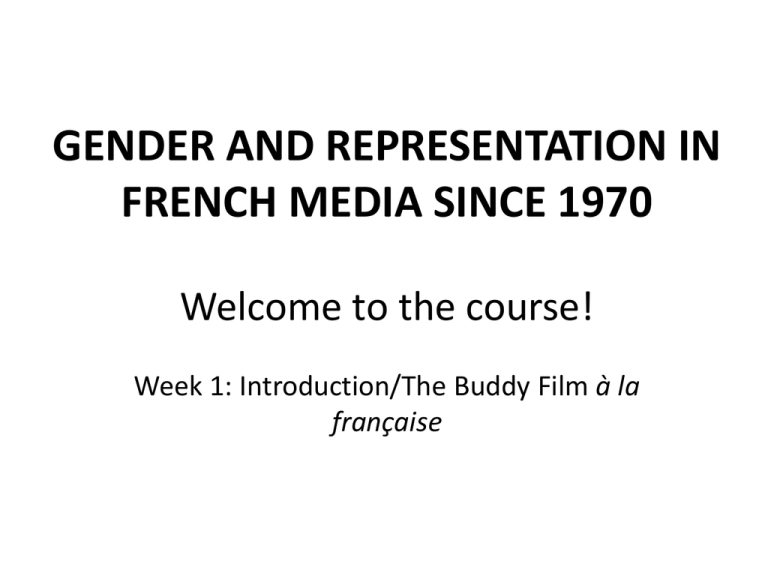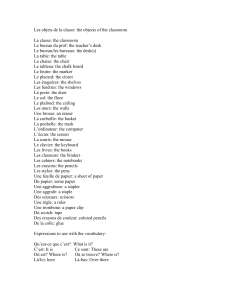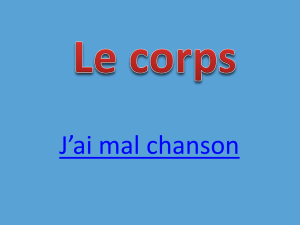
GENDER AND REPRESENTATION IN
FRENCH MEDIA SINCE 1970
Welcome to the course!
Week 1: Introduction/The Buddy Film à la
française
Structure of the First Session
Rationale of the course
• General background; why gender matters (cf. Stuart Hall).
• History of theorisations of gender roles in academia (French and Anglophone) and the
organisation of the course in relation to this.
Introduction to the history of gender roles and their representation in France
• Gender and feminism in French society since the 1970s (Christine Bard)
• Introduction to the representation of gender historically in French film and visual
culture
Blier and Les Valseuses
• Context of the film
• Sequence analysis (opening)
• Discussion of gender issues in Blier’s oeuvre and the film as a whole
(Late) Landmarks in Legislation Around Women’s Rights
in France
• Early 1900s: women allowed to manage property and income – around a century later
than women in the US and Britain.
• 1944: women’s suffrage (1918 in Britain, 1920 in the US).
• 1969-72: legislation grouped together under the heading of the Loi Neuwirth
legalising contraception, notably the pill (1961 in Britain, for married women).
• 1975: Loi Veil, decriminalising abortion (1967 in Britain); also divorce legal by mutual
consent.
May ‘68
Christine Bard, ‘Les Antiféminismes de la deuxième vague’
Her thesis throughout her book Un siècle d’antiféminisme is that feminist
movements are always shadowed by anti-feminist backlashes (cf. Susan
Faludi, Backlash: the Undeclared War Against American Women, 1991,
Susan J. Douglas, The Mommy Myth, 2004, or in France Elisabeth Badinter,
Le conflit: la femme et la mère, 2010, and others).
A key feature of 1970s French feminism:
Two strands: the previously dominant ‘courant différentialiste’ versus the
new more globally-influenced, equality-focused movements spearheaded
by the Mouvement de libération des femmes (MLF).
pp. 309-10 ‘L’enjeu de la libération sexuelle’: a problem area for
feminism
‘Avoir une sexualité “épanouie” est désormais reconnu comme une condition
nécessaire à l’équilibre psychique. Les années 1970 célèbrent la fin d’un long siècle
victorien. Les féministes ont participé à cette évolution, mais elles jouent aussi les
trouble-fête, car nombreux sont ceux qui pensent qu’une femme “libérée” est une
femme disponible, sexuellement, pour eux.’
La Marianne
Gender Representation in French Cinema
•
In 1988 Ginette Vincendeau has identified an ‘incestuous’ ‘father-daughter’ model of couple pairing in
classical (1930s) French cinema, in Vincendeau, ‘Daddy's Girls (Oedipal Narratives in 1930s French
Films).’ Iris no. 8: 70-81.
•
Noël Burch and Geneviève Sellier (see extra reading) identify this paradigm in 300 out of one thousand
films produced in that period and still frequent in decades since then. They point out that the term
‘incest’ allows us to relate screen thematics to ‘a psychosocial paradigm in real life, where the sexual
abuse of young girls by men having power over them is not merely a daydream’. (Burch and Sellier
2002, p.153)
Burch and Sellier also find this model to be frequent if not dominant in the portrayal of
romances in subsequent decades.
What about the New Wave?
See Geneviève Sellier, La Nouvelle Vague: un cinéma au masculin singulier. Paris: Broché, 2005,
Vincendeau (2000) in ‘New Wave, New Stars’ on ‘phantasmic male projections’ (p.113).
Truffaut: ‘Filmmaking is pointing the camera at beautiful
women.’
Á bout de souffle (J.-L. Godard, 1960)
1956
Jules et Jim (François Truffaut, 1962): an ambivalent intertext
Les Valseuses (1974)
5.7 million entries at French box office - succès de scandale
Context
• Disaffection among youth cut off from the Trente glorieuses (1945-75), in which France
underwent unprecedented economic expansion and modernization
• Economic dislocation and social strife following 1973 oil crisis (high oil prices due to
embargo by many producing nations)
• Global liberationist politics and movements in 1960s and 1970s; the rise of ‘counterculture’….
France’s answer to Easy Rider (1969)?
Compare Mammuth (Benoît
Delépine and Gustave de
Kervern, 2010)
Comic Buddy Duos
A transnational, transhistorical phenomenon.
La Commedia dell’Arte
But particularly common in French cinema? See
Raphaëlle Moine, Remakes: les films français à
Hollywood (Paris: CNRS Editions, 2007), 165-7.
The Problem of Gender in Bertrand Blier’s
Films
Filmography includes:
Brigitte Rollet, ‘“The Man Who Disliked Women: Blier – Misogynist or “Gynophobe”?’,
in R. Gunther and J. Windebak (eds.), Violence and Conflict in Modern French Culture (Sheffield Academic Press, 1994).
Rollet describes a ‘reduction of women to their
genitals. Blier’s characters are defined solely in
terms of their sexual organs and hence their
sexual activity’ (p. 241).
Sue Harris, ‘Bending Gender,’ [see extra reading]
‘Blier’s ambiguous construction of female
representation mounts a series of explicit challenges
to cinematic conventions […] Codes of attractiveness,
emotional response, and female corporeality are all
explored and subverted in Blier’s construction, and
[…] the comic potential of the female body in relation
to the male body, and the wider community is
highlighted.’
‘She is constructed not as the object of
travesty […] but rather as the vehicle for
travesty, the one who undoes the
“specific codes of coherence” [described
by Judith Butler] […] her consistently
ambiguous narrative function and
unconventional image also pose a threat
to the established gender hierarchy with
which spectators are familiar.’ (p.115)






